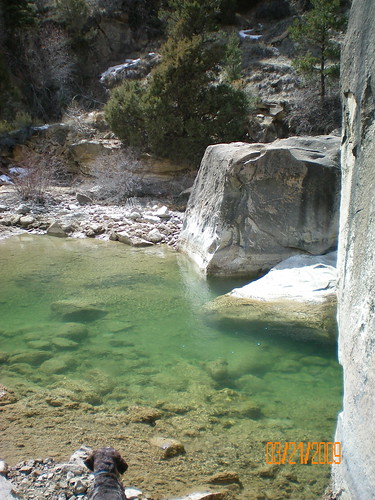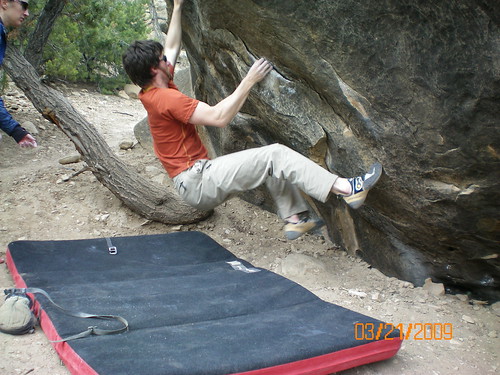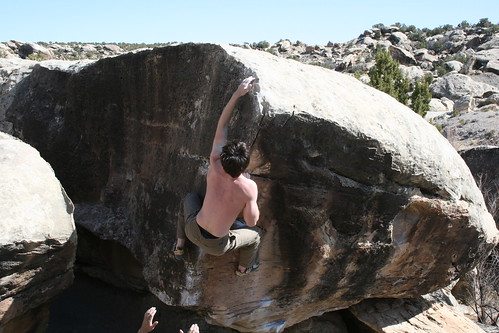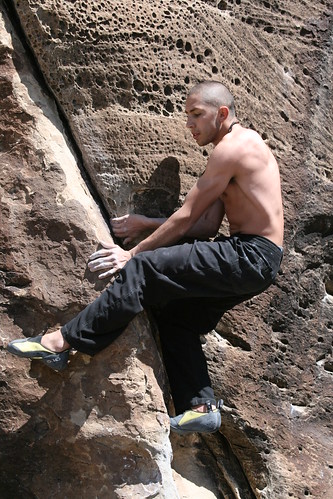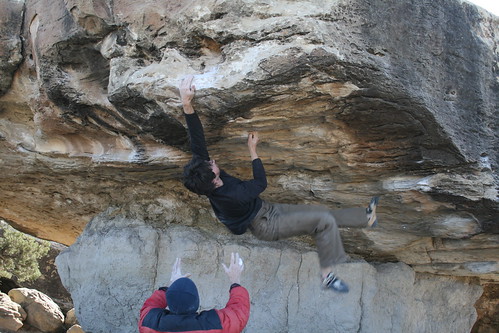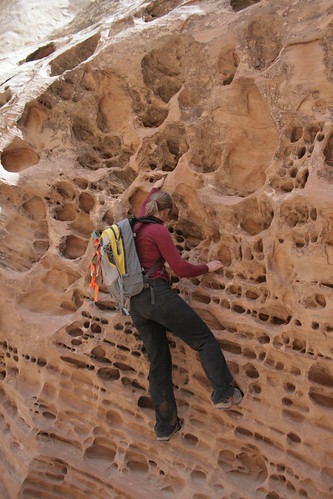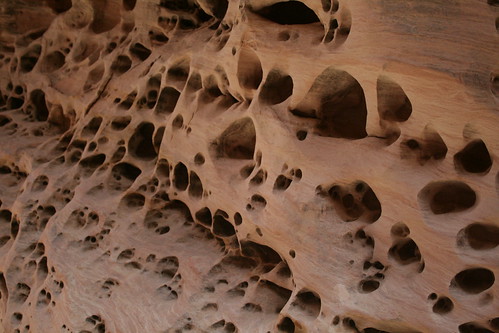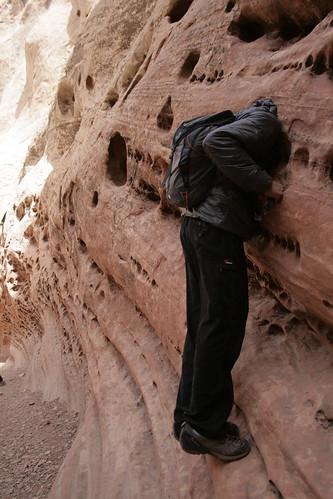Last week, I was out in southeast Utah looking for rattlesnake dens. Not something I really thought I'd be doing ever. I've seen plenty of rattlesnakes and am not overly afraid of them, but looking for them as they emerge from their dens has never been something that has crossed my mind as a good thing to do. It was quite an interesting experience as we went out with one of my co-workers who has been with the state for over 30 years. He is an amazing photographer and would frequently go out to photograph these snakes, but was afraid that when he retired, the knowledge of where the dens are would go with him. The location of dens is something we don't publicize, since a lot of people really really don't like snakes. Apparently a popular Easter activity at one of these sites is to go out for a picnic and shoot snakes. Other sites that are close to campgrounds and tourist attractions, other agencies have spent a great deal of time and effort to remove the snakes. And by remove, that does mean kill. If you move a rattlesnake somewhere within the range of it's den, it will just come back. If you move it a few miles away outside the range of it's den, it will just circle, looking for the den and die when winter comes and it can't find it. In spite of the general public's love of snakes, we were able to find quite a few. As the weather starts getting warmer in the spring, the snakes come out to the mouth of their den and warm in the sun for a few days while still going back in at night. Once they're good and warm for a few days, they leave and don't come back to that spot until the fall. We didn't see more than 6 or 8 at any one spot, but apparently if you hit it at the right time, you can see hundreds of snakes leaving their den at the same time.
Thursday and Friday, Tyrone Hayes was in salt Lake. He is one of the leading scientists looking at the use of the pesticide Atrizine and how it is one of the factors in global amphibian declines. Atrizine which is used primarily on corn and in forestry after clear cutting causes feminization of male frogs and makes them more likely to get other diseases and deformities. This alone was interesting to me, but Tyrone Hayes is one of the best speakers I have heard in a long time. As scientists, we often hear that we should be unbiased scientists and just let the science speak for itself. But when the chemical industry and federaly regulatory agencies who we trust to keep us safe turn a blind eye to very convincing science, that can be hard to do. Not only does this chemical make hermaphrodite frogs, it lowers sperm count in humans and has been linked to increased rates of breast and prostrate cancer in humans. Tyrone does and amazing job of making the science understandable and relevant to non-scientists and also brings in the human and social justice aspect. The people who have the highest exposure to atrizine are usually migrant workes and other low income minorities working in the fields and in the factory. Check out his website atrizinelovers.com for more information, and if you ever get the chance to hear him speak. Go! He can explain this far better and in a more interesting way than I can. He is the only scientist I've ever heard, conclude and summarize his talk in a spoken word / rap and actually be able to pull something like that off.
Sunday, April 26, 2009
Saturday, April 4, 2009
San Juan River


Last week, I got out for a rare week of field work on the San Juan River. The unfortunate thing about moving up in the world of biology is that you seem to get further and further away from what it was that got you into the job in the first place, being in the field.
The San Juan River flows through the very southeastern corner of Utah ending at the eastern end of Lake Powell. The headwaters are in the San Juan mountains in Colorado, so while where we were floating was very much the desert, the river is fed by distant snowfall. And like all the rest of the major rivers in the West, the flows are regulated by dams.
My trip down the San Juan was for the San Juan River Recovery Program. The San Juan is home to two endangered fish, the Colorado pikeminnow and the razorback sucker as well as three native fish which are not endangered, but are considered tier 1 or the most sensitive by Utah, the bluehead sucker, flannelmouth sucker and roundtail chub. The Colorado pikeminnow can grow up to 6 feet long, although fish this large have not been seen for many years. The razorback sucker is aptly named with a prominent, narrow ridge between its head and dorsal fin. Historically, these big river fish, especially the pikeminnow migrated hundreds of miles to their spawning grounds. Now their accessible spawning areas are much reduced by both large dams, small diversions and in the tributaries a complete dewatering. Although some of us may wish for the dams not to be there, the big ones we have are not going anywhere anytime soon and the goal of the recovery programs is to recover the species while still allowing for water development. It may seem like these are pretty contradictory goals, and in my more cynical thoughts, they very much are, but the reality is that humans need water too and while we definitely should be using it wiser than we often do, we do get water in the river and for the fish from these dams too. Part of the recovery program is flow requirements for critical habitat that requires minimum flows and flows that mimic a natural hydrograph during critical times for the fish.
Another major threat facing these fish, is the introduction of non-native fish. In the San Juan, the primary culprit is the channel catfish. I believe this was introduced to the San Juan through its stocking as a sport fish into Lake Powell and other reservoirs. The catfish provides a double whammy to the pikeminnow. Large catfish are very predacious on smaller native fish and while pikeminnow are also predators and eat small catfish, the catfish have spines which can get stuck in the pikeminnow as they are trying to eat it and can kill the pikeminnow.
So, the purpose of this and many trips down the San Juan, Green and Colorado Rivers is non-native removal by electroshocking. What this consists of on these large rivers is a crew of at least 5 people, 3 boats (2 electroshockers and 1 gear boat). The electroshocking boats are set up to send a current into the water at a voltage that stuns the fish, but doesn't cause any long-term harm. One person rows, keeping the boat as near the bank as possible while another stands at the front of the boat with a net, netting up all the non-native and endangered fish they see. The non-natives are counted, measured and removed from the system, while the endangereds are scanned for a tag, measured, weighed and returned to the river. The tag has an unique number so we can tell where it has moved from and how much it has grown.
The trip down the San Juan is beautiful and is very popular with recreational boaters, due to a fairly peaceful float through tall canyons of limestone and sandstone. There are a number of side canyons and hikes to explore as well. Unfortunately for a work trip, while it is still beautiful and enjoyable, you don't get to sit back and enjoy the scenery too much. You are either focused on rowing (trying to keep the boat near the shore without running into the shore, rocks or trees, while keeping your eye out for fish and turning the boat in whatever direction the fish are so they can be netted) or standing at the front of the boat, focused on the water in front of you ready to lunge with your net when something pops-up for sometimes just a second before it sinks back into the silty water. Another treat for all on the San Juan, is the last 12 or so miles which were inundated by Lake Powell when it was full. This deposited a lot of sand and left a nice bathtub line on the rocks. This stretch of the river is very flat and slow and you have to keep your eyes peeled for where it is deep enough so you don't get stuck in the sand bars. On my trip, this was also the day it was rainy, snowy and very windy, and the wind always blows upstream. This meant sometimes you were rowing as hard as you could just to stay still.
In spite of the wind and cold weather, it was a great trip. We removed a few thousand catfish, recaptured a few hundred pikeminnow, and a handful of razorback suckers. As far as the non-native removal goes, the San Juan is a place where we actually seem to be making some progress, over the last couple years, the catfish we catch are smaller and fewer. The San Juan is also being helped out by the drought in this aspect too. When Lake Powell receded from its full height, it created a waterfall about 10 miles downstream from where you take out from the river. This waterfall is preventing any additional catfish from invading as well as all of the other non-natives which are in Lake Powell. The downside is that any natives that go over this waterfall, are stuck downstream where they have little chance of surviving.
For me, this trip was a much needed reconnection with the river and reminder of why I spend most of my working hours in a office trying to help conserve our native fish.
*pictures will be coming soon, they're on a different computer
The San Juan River flows through the very southeastern corner of Utah ending at the eastern end of Lake Powell. The headwaters are in the San Juan mountains in Colorado, so while where we were floating was very much the desert, the river is fed by distant snowfall. And like all the rest of the major rivers in the West, the flows are regulated by dams.
My trip down the San Juan was for the San Juan River Recovery Program. The San Juan is home to two endangered fish, the Colorado pikeminnow and the razorback sucker as well as three native fish which are not endangered, but are considered tier 1 or the most sensitive by Utah, the bluehead sucker, flannelmouth sucker and roundtail chub. The Colorado pikeminnow can grow up to 6 feet long, although fish this large have not been seen for many years. The razorback sucker is aptly named with a prominent, narrow ridge between its head and dorsal fin. Historically, these big river fish, especially the pikeminnow migrated hundreds of miles to their spawning grounds. Now their accessible spawning areas are much reduced by both large dams, small diversions and in the tributaries a complete dewatering. Although some of us may wish for the dams not to be there, the big ones we have are not going anywhere anytime soon and the goal of the recovery programs is to recover the species while still allowing for water development. It may seem like these are pretty contradictory goals, and in my more cynical thoughts, they very much are, but the reality is that humans need water too and while we definitely should be using it wiser than we often do, we do get water in the river and for the fish from these dams too. Part of the recovery program is flow requirements for critical habitat that requires minimum flows and flows that mimic a natural hydrograph during critical times for the fish.
Another major threat facing these fish, is the introduction of non-native fish. In the San Juan, the primary culprit is the channel catfish. I believe this was introduced to the San Juan through its stocking as a sport fish into Lake Powell and other reservoirs. The catfish provides a double whammy to the pikeminnow. Large catfish are very predacious on smaller native fish and while pikeminnow are also predators and eat small catfish, the catfish have spines which can get stuck in the pikeminnow as they are trying to eat it and can kill the pikeminnow.
So, the purpose of this and many trips down the San Juan, Green and Colorado Rivers is non-native removal by electroshocking. What this consists of on these large rivers is a crew of at least 5 people, 3 boats (2 electroshockers and 1 gear boat). The electroshocking boats are set up to send a current into the water at a voltage that stuns the fish, but doesn't cause any long-term harm. One person rows, keeping the boat as near the bank as possible while another stands at the front of the boat with a net, netting up all the non-native and endangered fish they see. The non-natives are counted, measured and removed from the system, while the endangereds are scanned for a tag, measured, weighed and returned to the river. The tag has an unique number so we can tell where it has moved from and how much it has grown.
The trip down the San Juan is beautiful and is very popular with recreational boaters, due to a fairly peaceful float through tall canyons of limestone and sandstone. There are a number of side canyons and hikes to explore as well. Unfortunately for a work trip, while it is still beautiful and enjoyable, you don't get to sit back and enjoy the scenery too much. You are either focused on rowing (trying to keep the boat near the shore without running into the shore, rocks or trees, while keeping your eye out for fish and turning the boat in whatever direction the fish are so they can be netted) or standing at the front of the boat, focused on the water in front of you ready to lunge with your net when something pops-up for sometimes just a second before it sinks back into the silty water. Another treat for all on the San Juan, is the last 12 or so miles which were inundated by Lake Powell when it was full. This deposited a lot of sand and left a nice bathtub line on the rocks. This stretch of the river is very flat and slow and you have to keep your eyes peeled for where it is deep enough so you don't get stuck in the sand bars. On my trip, this was also the day it was rainy, snowy and very windy, and the wind always blows upstream. This meant sometimes you were rowing as hard as you could just to stay still.
In spite of the wind and cold weather, it was a great trip. We removed a few thousand catfish, recaptured a few hundred pikeminnow, and a handful of razorback suckers. As far as the non-native removal goes, the San Juan is a place where we actually seem to be making some progress, over the last couple years, the catfish we catch are smaller and fewer. The San Juan is also being helped out by the drought in this aspect too. When Lake Powell receded from its full height, it created a waterfall about 10 miles downstream from where you take out from the river. This waterfall is preventing any additional catfish from invading as well as all of the other non-natives which are in Lake Powell. The downside is that any natives that go over this waterfall, are stuck downstream where they have little chance of surviving.
For me, this trip was a much needed reconnection with the river and reminder of why I spend most of my working hours in a office trying to help conserve our native fish.
*pictures will be coming soon, they're on a different computer
Wednesday, April 1, 2009
The Good, the Bad, and the Ugly

It's spring break time and that means all the college students are out climbing! Elyse came to Utah for a week and a half of action packed climbing. The day she flew into town we took her to Rock Canyon for some evening climbing. The weather was perfect and the broken quartzite was sharp and positive. Over the weekend we headed to Joe's Valley for some sandstone bouldering. We had a decent sized group with us consisting of a new friend Collin, Chris, Peter, Elyse, Cassie, and I. Everyone warmed up on "Small One" before I took the crew down to the riverside boulders to escape the climbing crowd. We've never seen that many people at Joe's before. After conversing with some fellow climbers we found that it was due to the out-of-towners from Colorado and beyond. Regardless, we had a great day of climbing. Cassie came very close to sending a V6 and I sent my second V6 so we were quite happy with it.
The next day Elyse and I went to a piece of art on the great salt lake called the Spiral Jetty. It was cool, but as the water level was quite low there wasn't really any jetty at all. The water was about 100 yards out from the spiral. I also high-centered the honda civic and we had to get a pull out from a couple of nice guys with a decent sized SUV. It was epic since there was a snow storm coming and not really anybody else anywhere nearby for at least 20 miles. Oh well at least it made for good storytelling afterwards.
Cassie headed to the San Juan river for a 5-day float trip of catching disposing of unwanted sport fish which are causing problems for the native species who used to thrive in the rivers.
The following weekend we decided to make a camping trip of climbing at Triassic on Saturday and then heading to Little Wild Horse Canyon.
Climbing at Triassic was sweet. The weather was outstanding and some hard problems were sent. Most of the sending was by our uber-hard sending friend Andrew and not us, but we were certainly happy for him. It's very cool to climb with someone who inspires you to try harder, and Andrew certainly does that. His girlfriend Rachel (sp?) also came for the weekend. She's a hard climber as well and left with a tough V4 project that she is working. We had a beautiful day of climbing which ended on a boulder that has 3 problems on it, each with the same start, and a different finish. The Good a V4 has a pretty scary topout over a bad landing, The Bad a V5 has a crazy throw for a jug, and the Ugly is a very long V6 that has some stout moves with long reaches between holds. Andrew impressed everyone by flashing or onsighting all three problems. I contented myself with trying the V5 and came close to sending, but just didn't have the juice to finish. No worries though, we're heading back to Triassic this coming Sunday since the weather in Provo looks like it will be either Bad, or Ugly :)
Sunday we drove out to Little Wild Horse and were shocked at how windy it was. It was tough just keeping the car in the lane at some points due to crazy gusting the wind was. We ended up getting to the canyon a bit before noon and hiked into the canyon with my famous words of "I'm sure it won't be so windy in the canyon". Much to my disappointment the opposite was true. The soft sand in the canyon was being picked up by strong winds and thrown into our faces like a sandblaster. It was brutal. I didn't know sand could get into that many places on my body. Luckily the scenery made up for the conditions and we had a great time exploring the slot. It was strange to see that even the narrowest parts were actually dry this year. Two years ago (almost exactly) we did the same hike with Cassie's parents and there was water through a decent portion of the slot which required wading through ice cold water to continue the hike. This year there wasn't even a puddle, which was disappointing to Cassie and I. We kind of liked the extra work that the water forces on us. Instead of doing the loop hike we exited the same way we came, one reason was that mojo was with us and I didn't want to have to carry him up and down some of the boulder jams, another was that the wind was making the hiking unpleasant enough that everyone was pretty happy to just call it a day and plan to come back to hike Bell canyon another day when the weather would be more cooperative. On another note I was very happy with the pictures my Canon SLR camera took. It really performed well in the low light conditions and I ended up getting some nice shots. Feel free to check out our flickr page (as always) for lots more pictures that you see here.
Little Wild Horse Pictures
Joes Valley Pictures
Triassic Pictures
Little Wild Horse Pictures
Joes Valley Pictures
Triassic Pictures
Subscribe to:
Posts (Atom)
